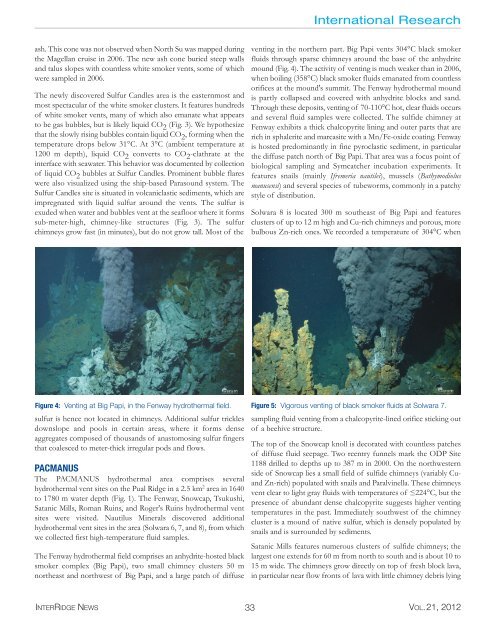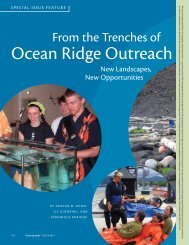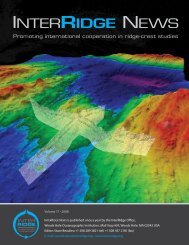Full version, low resolution, 7.5MB - InterRidge
Full version, low resolution, 7.5MB - InterRidge
Full version, low resolution, 7.5MB - InterRidge
Create successful ePaper yourself
Turn your PDF publications into a flip-book with our unique Google optimized e-Paper software.
International Research<br />
ash. This cone was not observed when North Su was mapped during<br />
the Magellan cruise in 2006. The new ash cone buried steep walls<br />
and talus slopes with countless white smoker vents, some of which<br />
were sampled in 2006.<br />
The newly discovered Sulfur Candles area is the easternmost and<br />
most spectacular of the white smoker clusters. It features hundreds<br />
of white smoker vents, many of which also emanate what appears<br />
to be gas bubbles, but is likely liquid CO 2 (Fig. 3). We hypothesize<br />
that the s<strong>low</strong>ly rising bubbles contain liquid CO 2 , forming when the<br />
temperature drops be<strong>low</strong> 31°C. At 3°C (ambient temperature at<br />
1200 m depth), liquid CO 2 converts to CO 2 -clathrate at the<br />
interface with seawater. This behavior was documented by collection<br />
of liquid CO 2 bubbles at Sulfur Candles. Prominent bubble flares<br />
were also visualized using the ship-based Parasound system. The<br />
Sulfur Candles site is situated in volcaniclastic sediments, which are<br />
impregnated with liquid sulfur around the vents. The sulfur is<br />
exuded when water and bubbles vent at the seafloor where it forms<br />
sub-meter-high, chimney-like structures (Fig. 3). The sulfur<br />
chimneys grow fast (in minutes), but do not grow tall. Most of the<br />
venting in the northern part. Big Papi vents 304°C black smoker<br />
fluids through sparse chimneys around the base of the anhydrite<br />
mound (Fig. 4). The activity of venting is much weaker than in 2006,<br />
when boiling (358°C) black smoker fluids emanated from countless<br />
orifices at the mound's summit. The Fenway hydrothermal mound<br />
is partly collapsed and covered with anhydrite blocks and sand.<br />
Through these deposits, venting of 70-110°C hot, clear fluids occurs<br />
and several fluid samples were collected. The sulfide chimney at<br />
Fenway exhibits a thick chalcopyrite lining and outer parts that are<br />
rich in sphalerite and marcasite with a Mn/Fe-oxide coating. Fenway<br />
is hosted predominantly in fine pyroclastic sediment, in particular<br />
the diffuse patch north of Big Papi. That area was a focus point of<br />
biological sampling and Symcatcher incubation experiments. It<br />
features snails (mainly Ifremeria nautilei), mussels (Bathymodiolus<br />
manusensi) and several species of tubeworms, commonly in a patchy<br />
style of distribution.<br />
Solwara 8 is located 300 m southeast of Big Papi and features<br />
clusters of up to 12 m high and Cu-rich chimneys and porous, more<br />
bulbous Zn-rich ones. We recorded a temperature of 304°C when<br />
Figure 4: Venting at Big Papi, in the Fenway hydrothermal field. Figure 5: Vigorous venting of black smoker fluids at Solwara 7.<br />
sulfur is hence not located in chimneys. Additional sulfur trickles<br />
downslope and pools in certain areas, where it forms dense<br />
aggregates composed of thousands of anastomosing sulfur fingers<br />
that coalesced to meter-thick irregular pods and f<strong>low</strong>s.<br />
PACMANUS<br />
The PACMANUS hydrothermal area comprises several<br />
hydrothermal vent sites on the Pual Ridge in a 2.5 km 2 area in 1640<br />
to 1780 m water depth (Fig. 1). The Fenway, Snowcap, Tsukushi,<br />
Satanic Mills, Roman Ruins, and Roger's Ruins hydrothermal vent<br />
sites were visited. Nautilus Minerals discovered additional<br />
hydrothermal vent sites in the area (Solwara 6, 7, and 8), from which<br />
we collected first high-temperature fluid samples.<br />
The Fenway hydrothermal field comprises an anhydrite-hosted black<br />
smoker complex (Big Papi), two small chimney clusters 50 m<br />
northeast and northwest of Big Papi, and a large patch of diffuse<br />
sampling fluid venting from a chalcopyrite-lined orifice sticking out<br />
of a beehive structure.<br />
The top of the Snowcap knoll is decorated with countless patches<br />
of diffuse fluid seepage. Two reentry funnels mark the ODP Site<br />
1188 drilled to depths up to 387 m in 2000. On the northwestern<br />
side of Snowcap lies a small field of sulfide chimneys (variably Cuand<br />
Zn-rich) populated with snails and Paralvinella. These chimneys<br />
vent clear to light gray fluids with temperatures of ≤224°C, but the<br />
presence of abundant dense chalcopyrite suggests higher venting<br />
temperatures in the past. Immediately southwest of the chimney<br />
cluster is a mound of native sulfur, which is densely populated by<br />
snails and is surrounded by sediments.<br />
Satanic Mills features numerous clusters of sulfide chimneys; the<br />
largest one extends for 60 m from north to south and is about 10 to<br />
15 m wide. The chimneys grow directly on top of fresh block lava,<br />
in particular near f<strong>low</strong> fronts of lava with little chimney debris lying<br />
INTERRIDGE NEWS 33 VOL.21, 2012
















